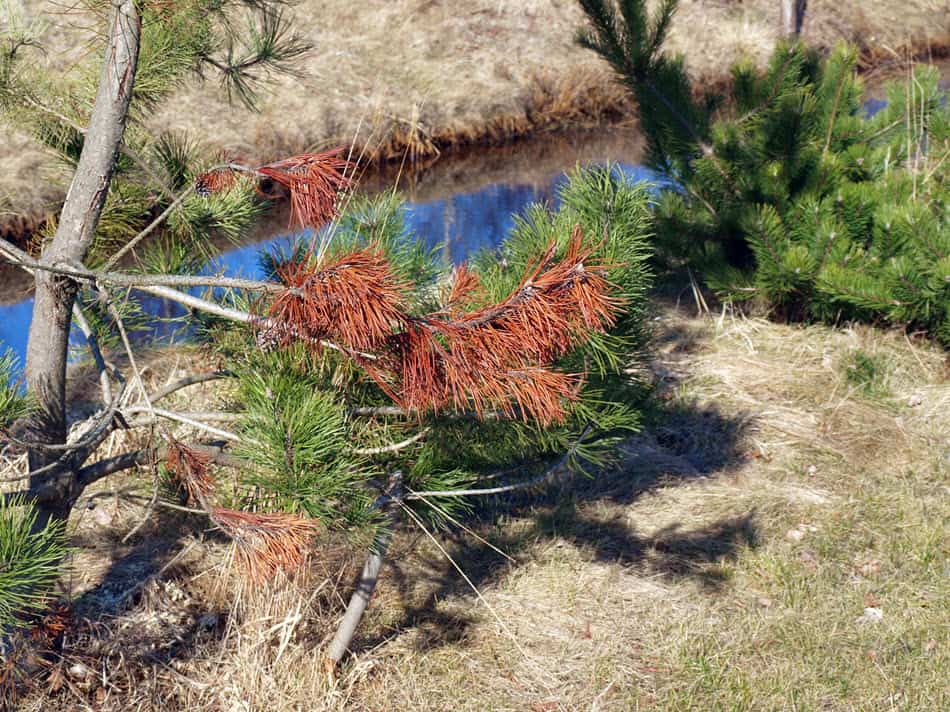
My neighbor was walking around his yard the other day so I thought I would go say “Hi” and see what he has been up to. When I approached he was looking up into his trees. Curious I ask what he was doing. He replied, “Should I let nature take its course or cut out the dead branches?”
Should I prune dead branches? Yes, as you notice dead branches, you should cut them off, if possible, no matter what time of year it might be. This will speed up the healing process and potentially prevent an accident which could hurt someone or damage property.
Pruning dead branches can have several benefits that most people don’t even
Does Cutting Off Dead Branches Help A Tree?
Yes, it can help a tree to prune the dead branches as they arise and it will make the tree look so much better and less cluttered looking.
Disease and Insects
Trees have a remarkable way of compartmentalizing dead wood so that it doesn’t effect the rest of the good, live wood. But you have the power to help the tree along with the healing so that the timeframe is greatly shortened which will allow the tree to carry on with growing.
Dead branches can invite unwanted insects and disease to any tree. Some trees are more susceptible such as oaks and dogwoods. As the branch rots the tree branch collar will grow to heal off the branch once it comes off either by pruning or by nature which can take many months to years depending on how big the limb is.
If you look closely at where the branch goes off the tree trunk you will see bark that is bigger in diameter than the branch itself. This is called the branch collar. This special wood will quickly grow over the branch area once it is cut off or once it falls off from rot.
This enables the tree to prevent unwanted insects and rot from attacking the rest of the tree.
By being proactive and pruning off any dead limb you can greatly speed up the healing process and therefore preventing harm to your tree.
Harming Itself
Little dead branches are not too big of a concern, but if a branch is a couple of inches in diameter or bigger they can cause damage to live limbs that are below them as they fall.
The weight and span of bigger dead branches can scrape live branches or crack live branches or worse yet break live branches as they fall to the ground not caring what is in the way.
This can cause considerable damage to your tree. If you see a dead branch of considerable size up in your tree, just picture how it will fall. Will it hit any good branches on the way down?
If so you will want to be proactive and remove the dead branch in a controllable way so that it does damage any other branches in your tree.
Safety Issues
Dead branches can be a nuisance with all the little dead twigs falling as it completes the dying cycle. Dead limbs will rot with the smallest diameter parts going first.
As the cycle progresses the larger diameter parts of the limb will start to rot enough to break off and fall the to the ground. These limb sections can weigh several hundred pounds.
If a person or pet would happen to be under the tree when the dead branch breaks off there is a strong potential for injury.
If you have a car parked under a tree with dead branches there can be considerable damage to the vehicle if the limb falls during a wind gust or storm.
The same goes for a house or other structure that might happen to be under a bigger tree with dead branches.
From time to time look up at your tree’s canopy to see if you notice any limbs that might be on there way out. Then look down to see what might in the path of a falling dead limb.
How To Prune a Dead Branch
The process is basically the same as a live branch, but the situation might be less stable. Dead branches that have had months or years to rot can become less predictable when trying to prune them back.
A Word Of Caution
Severely rotten branches can break off in several sections so you must be prepared for that. If you are using a pruning saw the side to side motion can cause the branch to break off in places other than where you are cutting and the momentum can cause the branch to fly off to the side instead of just straight down.
If the branch recently died it will behave very similar to a live branch when you cut it. Branches that died the season or two before are the ones to watch out for when pruning.
If the limb is several inches in diameter you will want to take it down in pieces using ropes so that it doesn’t damage anything under it on the way down.
You will want to make the first cut several inches away from where you want the finish cut to be. Start by making a cut underneath about a 1/3 of the way up through the branch. Then make a cut from the top all the way through just to the side that you are cutting off from the under cut you just made.
Once you have remove the majority of the limb then you can make the third cut just before the branch collar or next to a forked branch if you are only taking out a section of the total branch.
This will enable the tree to heal over very quickly.
Watch Out For The Explosion
When dead, rotten branch strike the ground then can literally explode into hundreds of piece which tend to fly in every direction. Make sure the landing zone is completely clear and you have protected ground items from being struck by flying debris.
Why Does My Tree Have Dead Branches?
There can be many reasons for tree branches to die.
- Too shady – As the tree grows lower branches will normally get shaded out and die off as the tree grows.
- Storm damage – Storms passing through can crack or break limbs which will cause them to die over time. It might not show immediately after a storm.
- Dry weather – Dry soil conditions can put extreme stress on a tree which in turn will cause it to start losing limbs.
- Diseases – The tree might have a disease attacking it which is using caused by insects that carry diseases from one tree to another. If there isn’t an obvious sign as to why your branch died you might contact your local Agricultural Extension Service.
- Wet weather – If the soil is too wet for the type of tree, it can slowly kill the tree which might have symptoms of branches dying.
- Rope or Wire – People hang swings, bird feeder, chimes, and many other things from there tree branches all the time not considering that it might harm the branch. As the tree grows it can be griddled by the wire or rope which will prevent the nutrients from circulated
through out the limb.
If you can’t determine what the cause is then it is best to bring in an Arborist to help solve the mystery and hopefully correct the issue in order to save your tree.
When Can You Cut Branches Off Trees?
With normal, live branches you want to pay attention to what time of year it is so that you don’t create a situation which will hurt the trees health such as inviting bad insects or severe oozing of tree sap.
With dead branches you can and should prune them anytime you notice them. They don’t have sap running through them so that isn’t an issue. The branch is already exposing the tree to insects that could harm the tree so the cut will not change that fact.
Will Dead Branches Grow Back?
Dead branches will not “heal” themselves. Once a branch dies it will not come back to life.
If the whole branch isn’t dead you can just trim the dead part of the branch back to where it is still alive at a fork branch area. Don’t leave a stub when you prune back the branch.
The part of the branch that is still alive can grow to fill in the space that the dead branch left.
Related Questions
How to cut branches from a tall tree: Unfortunately, not all branches are at a great height to reach to work on them. There are several ways to prune higher branches. With pole pruners or pole saws, you can reach upwards of 40 feet. Here is a complete list of ways you can prune high branches.
Is it OK to trim trees in the fall? In general, NO. It is much better to wait until the tree is completel dormant which means later into the winter until just before the tree buds begin to swell. The big exceptions for pruning are maple, walnut, and birch trees which should be pruned mid-summer to early fall.
